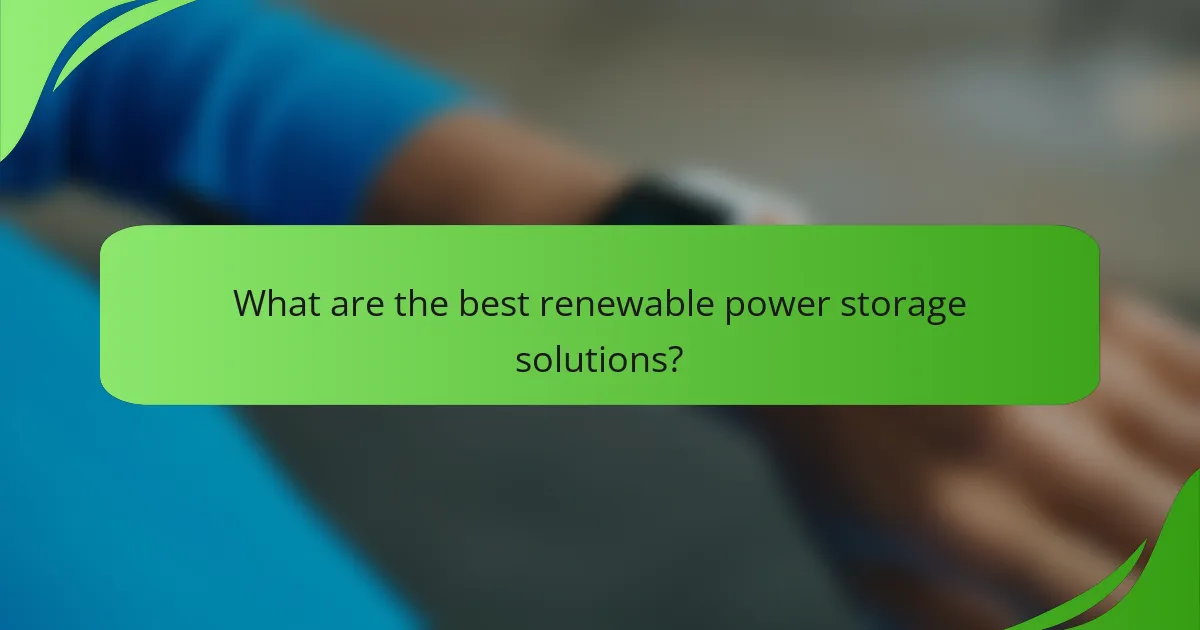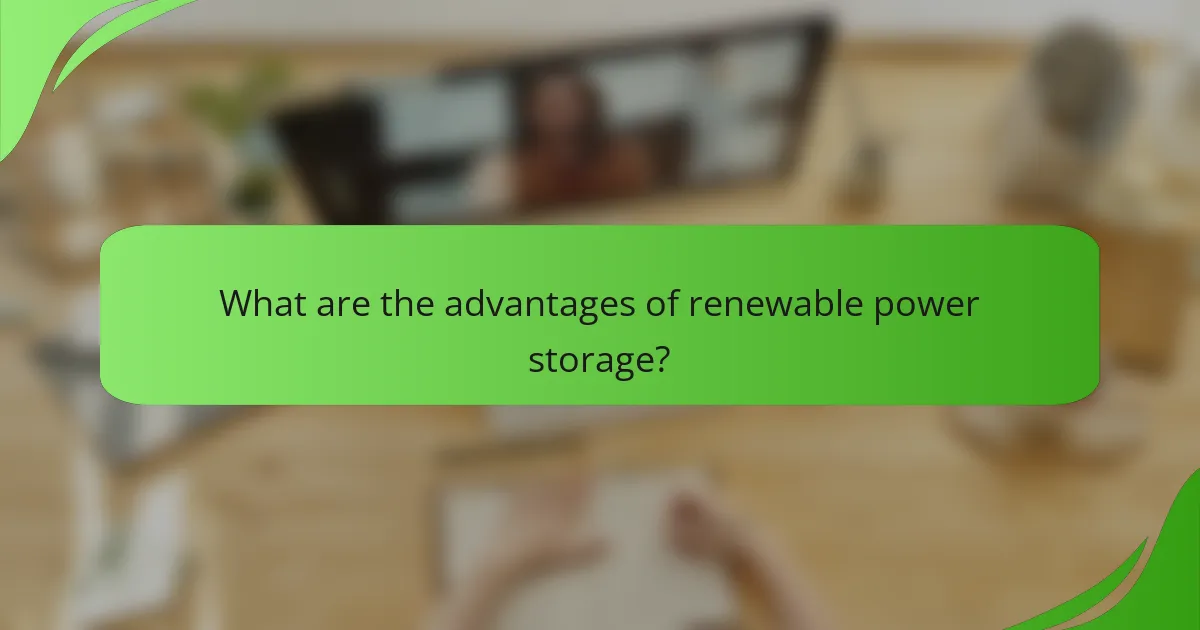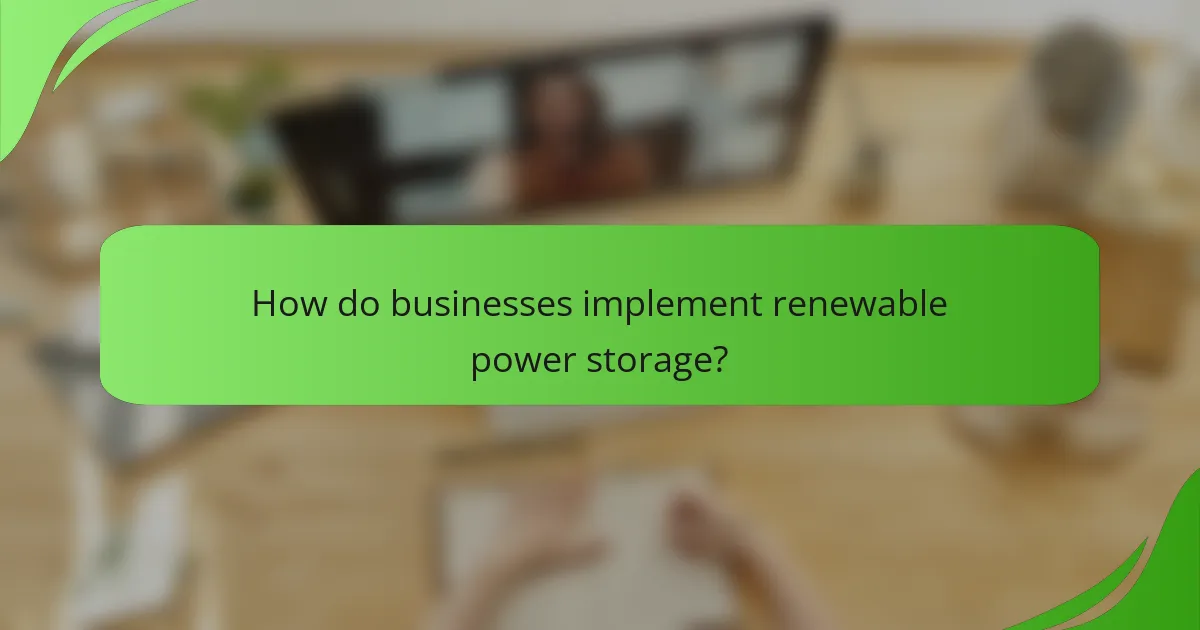Renewable power storage solutions play a crucial role in enhancing the efficiency and reliability of renewable energy systems. Options such as lithium-ion batteries, pumped hydro storage, and compressed air energy storage each offer distinct advantages and challenges, making them suitable for various business applications. While these technologies provide significant benefits like improved grid stability and long-term cost savings, they also face drawbacks such as high initial costs and environmental concerns. Understanding both the pros and cons is essential for businesses looking to invest in sustainable energy solutions.

What are the best renewable power storage solutions?
The best renewable power storage solutions include lithium-ion batteries, pumped hydro storage, flow batteries, compressed air energy storage, and solid-state batteries. Each option has unique characteristics, advantages, and challenges that make them suitable for different applications in renewable energy systems.
Lithium-ion batteries
Lithium-ion batteries are widely used for energy storage due to their high energy density and efficiency. They work by moving lithium ions between the anode and cathode during charging and discharging, allowing for rapid energy release and recharge cycles.
These batteries are ideal for applications such as electric vehicles and residential solar energy systems. However, they can be expensive and have a limited lifespan, typically lasting around 5 to 15 years depending on usage and conditions.
Pumped hydro storage
Pumped hydro storage is a mature technology that uses two water reservoirs at different elevations. During periods of low energy demand, excess electricity is used to pump water from the lower reservoir to the upper one. When demand increases, the stored water is released to generate electricity by flowing back down.
This method is highly efficient, with round-trip efficiencies often exceeding 70%. However, it requires significant geographical features and large-scale infrastructure, making it less feasible in urban areas or regions without suitable topography.
Flow batteries
Flow batteries store energy in liquid electrolytes contained in external tanks. This design allows for scalable energy storage, as the energy capacity can be increased simply by enlarging the tanks. They are particularly useful for applications that require long-duration energy storage.
While flow batteries have a longer lifespan than lithium-ion batteries, they tend to have lower energy densities and can be more expensive. They are gaining traction in grid-scale applications where long discharge times are beneficial.
Compressed air energy storage
Compressed air energy storage (CAES) involves using excess electricity to compress air in underground caverns or tanks. When energy is needed, the compressed air is released, heated, and used to drive turbines to generate electricity. This method is effective for large-scale energy storage.
CAES systems can provide substantial storage capacity and are suitable for balancing supply and demand on the grid. However, they require specific geological formations and can have lower efficiencies compared to other storage technologies.
Solid-state batteries
Solid-state batteries utilize a solid electrolyte instead of a liquid one, which enhances safety and energy density. They have the potential to offer higher performance and longer lifespans compared to traditional lithium-ion batteries.
While still in the development phase for many applications, solid-state batteries could revolutionize energy storage in electric vehicles and portable electronics. Their commercial viability is expected to improve as manufacturing processes advance and costs decrease.

What are the advantages of renewable power storage?
Renewable power storage offers several key advantages, including improved energy reliability, enhanced grid stability, long-term cost savings, and significant environmental benefits. These advantages make renewable energy systems more efficient and sustainable, facilitating a transition to cleaner energy sources.
Increased energy reliability
Renewable power storage systems, such as batteries and pumped hydro storage, help ensure a consistent energy supply, even when generation is intermittent. By storing excess energy during peak production times, these systems can release power when demand is high or generation is low, reducing the risk of outages.
For example, solar energy can be stored during sunny days and used during cloudy periods or at night. This capability is crucial for maintaining energy reliability in regions heavily reliant on renewable sources.
Enhanced grid stability
Energy storage solutions contribute to grid stability by balancing supply and demand in real-time. They can respond quickly to fluctuations in energy consumption, helping to prevent grid overloads or failures.
Incorporating storage systems allows grid operators to manage renewable energy integration more effectively, reducing the need for fossil fuel backup generation and enhancing overall system resilience.
Cost savings over time
Investing in renewable power storage can lead to significant cost savings in the long run. By reducing reliance on peak power purchases, which are often more expensive, businesses and utilities can lower their energy bills.
Additionally, advancements in technology are driving down the costs of storage solutions, making them more accessible. Over time, the return on investment can be substantial, especially when considering potential incentives and rebates available for renewable energy projects.
Environmental benefits
Renewable power storage plays a vital role in reducing greenhouse gas emissions by enabling a greater share of clean energy in the grid. By storing and utilizing renewable energy, these systems help decrease reliance on fossil fuels, leading to a cleaner environment.
Moreover, energy storage can facilitate the integration of more renewable sources, such as wind and solar, further decreasing the carbon footprint of energy production. This transition is essential for meeting global climate goals and promoting sustainable development.

What are the disadvantages of renewable power storage?
Renewable power storage solutions, while essential for energy management, come with notable disadvantages that can impact their feasibility and efficiency. Key drawbacks include high initial costs, limited lifespan, resource availability issues, and environmental impacts associated with the materials used.
High initial costs
The upfront investment required for renewable power storage systems can be substantial. Technologies like lithium-ion batteries or pumped hydro storage often demand significant capital, which can deter businesses from adopting these solutions. For instance, the installation of a large-scale battery system may run into the hundreds of thousands to millions of dollars, depending on capacity and technology.
Companies should weigh these initial costs against potential long-term savings and benefits, such as reduced energy bills and increased energy independence. Exploring financing options or government incentives can help mitigate these expenses.
Limited lifespan
Many renewable storage systems have a finite operational lifespan, which can lead to additional costs over time. For example, lithium-ion batteries typically last between 5 to 15 years, depending on usage and maintenance. Once they reach the end of their life, replacement costs can be significant.
Understanding the expected lifespan of a chosen storage technology is crucial for businesses. Regular maintenance and proper usage can extend the life of these systems, but planning for eventual replacement is essential for budget management.
Resource availability issues
The materials required for renewable storage technologies can be subject to availability constraints. For instance, lithium and cobalt, essential for battery production, are often sourced from specific regions, which can lead to supply chain vulnerabilities. Fluctuations in resource availability can impact costs and project timelines.
Businesses should consider the sourcing of materials and potential geopolitical risks when investing in renewable storage solutions. Diversifying suppliers and exploring alternative technologies can help mitigate these risks.
Environmental impact of materials
The production and disposal of materials used in renewable power storage can have environmental consequences. Mining for lithium, cobalt, and other minerals can lead to habitat destruction and pollution. Additionally, the end-of-life disposal of batteries poses challenges, as improper disposal can result in hazardous waste.
To address these concerns, businesses should prioritize sustainable sourcing and recycling initiatives. Engaging with suppliers who adhere to environmental standards can help minimize the ecological footprint of renewable storage solutions.

How do businesses implement renewable power storage?
Businesses implement renewable power storage by integrating energy storage systems with their existing energy infrastructure. This allows them to store excess energy generated from renewable sources for later use, enhancing energy efficiency and reliability.
Energy management systems
Energy management systems (EMS) are crucial for businesses looking to optimize renewable power storage. These systems monitor energy consumption and production, enabling companies to make informed decisions about when to store or use energy. By analyzing data in real-time, businesses can reduce costs and improve their sustainability efforts.
Implementing an EMS involves selecting appropriate software and hardware that can integrate with existing systems. Companies should focus on scalability and compatibility to ensure that the EMS can grow with their energy needs.
Integration with solar and wind
Integrating renewable power storage with solar and wind energy sources is essential for maximizing efficiency. Businesses can use batteries or other storage technologies to capture excess energy generated during peak production times. This stored energy can then be deployed during periods of low generation, ensuring a consistent power supply.
For effective integration, companies should consider the capacity of their storage systems relative to their renewable generation capabilities. A common approach is to aim for a storage capacity that can hold at least 20-30% of the average daily energy production from renewable sources.
Regulatory compliance
Compliance with local regulations is a vital aspect of implementing renewable power storage solutions. Businesses must navigate various laws and standards that govern energy storage systems, which can vary significantly by region. Understanding these regulations helps avoid potential fines and ensures that the systems are eligible for incentives.
Companies should consult with legal experts or industry associations to stay updated on relevant regulations. Additionally, they should consider certifications that demonstrate compliance, which can enhance their credibility and appeal to environmentally conscious consumers.
